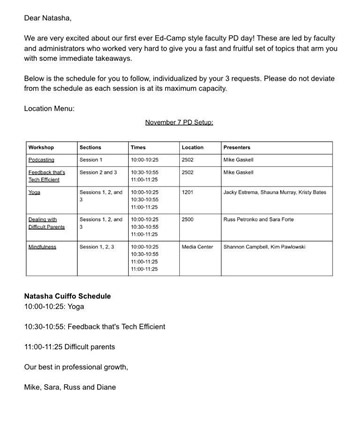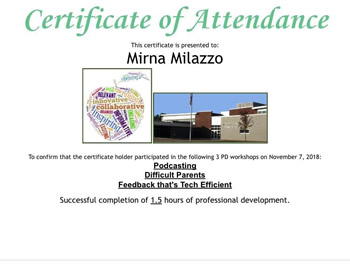If you’re like most educators, you don’t have the time to waste on unproductive faculty meetings. That’s why administrators and teacher leaders should transform faculty meetings into engaging professional development (PD) opportunities. We did that in my school and increased faculty attendance by 10 percent on faculty meeting days! You can find out more about how we did this here.
Want to take it even further with engaging, interactive professional learning community (PLC)-style faculty meetings? You can elevate the motivation and learning to heights that seem unreachable. But they are reachable. How? Edcamp-style faculty meetings!
An edcamp is a participant-driven conference, commonly referred to as an “unconference,” for K-12 educators. Edcamps are typically free and built around community participation and organization. If you’re interested in empowering your faculty with the same motivation and learning that transcends to student achievement, you’ll want to replicate how we turned our faculty meetings into mini edcamps. Here are the steps that any school can follow.
1. Designate an organizer.
Anyone can be the organizer: a principal, supervisor, teacher leader, or even a respected informal leader in your school. Basically, you need someone with faculty-wide influence.
2. Create a topic list.
Survey your faculty on the topics they are interested in learning about. You can do this using Google Forms or informally, especially if you have direct access to faculty suggestions.
Next, build a list of topic ideas. You’ll want enough choices to allow your faculty to select from a menu. If something faculty wanted doesn’t make the list, you can do another edcamp later in the school year. For instance, our school community expressed interest in five different topics.

In a one-hour faculty meeting, you could do two 25-minute sessions or have three 20-minute sessions. I recommend a little space between sessions to allow faculty to transition. We first tried this on a 90-minute PD day, so faculty got to attend three 25-minute sessions.
I taught two topics: Podcasting and Technology Efficient Feedback. My assistant principals taught Dealing with Difficult Parents. I would like to tell you that we “recruited” faculty leaders to teach Mindfulness and Yoga, but they came to me offering their services! If you already run “un-faculty” meetings, that’s what happens. If not, recruit with a smile. There’s more power in persuasion than force!
3. Develop a registration process.
Set up a Google Form to allow faculty to sign up for their choices. Google Forms allows you to limit the number of choices. Our faculty chose three from our five options. If someone didn’t sign up by a deadline date, my secretary called them, but less than 10 percent of the faculty needed that call!
Based on the number of faculty selecting each choice, add or decrease sections. For instance, 30 faculty signed up for Podcasting. Therefore, I needed to run only one session. Ninety-five signed up for Mindfulness so we ran three sessions.
4. Schedule your room locations.
Once you’ve determined the number of sessions and assigned faculty to each, assign rooms, preferably close together to minimize transition time between. I used a mail merge tool in Google Drive to grab faculty selections from the spreadsheet associated with the form they submitted and populated a personalized invitation to each session and sent these to faculty. They loved this personalized invitation and it really helped organize the event. If you are not as tech-geeky as me, simply email them or arrange their assignments in a schedule, listing everyone on one document for them to follow.

5. Emphasize to faculty that this is an opportunity to pique their interest.
The beauty of edcamp-style faculty meetings is you can always bring topics back or, more importantly, let them experiment as a group so that they can troubleshoot together at a future meeting. In my session, I gave a “how-to” instructional that reinforced what I demonstrated and offered five minutes of Q&A at the end. This also allowed faculty to share ideas about how they might use the newly learned concept, which created a shared feeling of “Oh yeah, I never thought of that” between colleagues.
6. Consider this as a continuum.
At the end of the final edcamp session, consider this as ongoing or a great idea will die. There are three important steps I follow to ensure this doesn’t happen:
- Issue personalized certificates of completion. You can find templates easily online.

- Follow up with survey feedback (ask what went well, what suggestions do you have, what would you like to see at a future session).
- Offer follow-up PD in team, department, or future faculty meetings, based on their needs/requests.
All of the above guarantees that your faculty remains invested, energized, and motivated to continue learning through their own unique PD format. That’s empowerment!
- 3 ways to avoid summer learning loss - April 19, 2024
- High school students say AI will change the workforce - April 18, 2024
- Motivating students using the Self-Determination Theory - April 17, 2024


